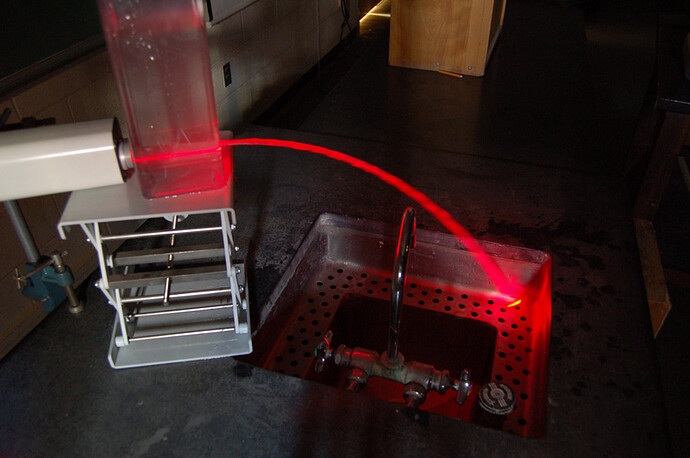I found these little guys last night, and I thought the operating principle was just too fascinating not to share! They’re passive(ish), sealed, solid state liquid contact sensors:
It’s an IR LED and photo-transistor pair in a plastic housing. The emitter and detector are positioned with respect to the lens such that total internal reflection occurs, and the photo-transistor is normally on.
Side note: Total internal reflection is awesome! Remember from junior high science class, light travels at different speeds in different media, in this case light travels slower in the plastic housing of the sensor than in air. When light crosses a boundary between two materials, it immediately speeds up, or slows down depending. When a beam of light hits this boundary at an angle, this speed change results in a sharp bend in the beam at the boundary. When the light is traveling from a slower medium to a faster medium, it bends back towards the boundary, and past some critical angle (depending on the difference between the refractive indices of the two media) the light is actually bent back around to the starting side of the boundary:

If you have a flat-sided fish tank around, you can look straight through it and see what’s on the other side. If you look in one side and out one perpendicular to it, you should be able to move your head side to side and see a reflection of the inside of the tank forming and disappearing. That’s total internal reflection.
Diamonds have a very high refractive index, and total internal reflection is what gives them their distinctive sparkle (and one way a trained jeweler can tell a cubic zirconia by looking at it). Total internal reflection is also why fiber-optics works, as well as the cool experiment of bending a laser (or even just a flashlight beam) in a curved stream of water:
Anyway, this is super cool because you can have this sensor out in the air or probably even touch it with your finger, or pack it in dirt for that matter (mine is still in the mail, so I’m not 100% sure of this) and the detector will still be triggered by the internally reflected light from the emitter. But any liquid will have a refractive index closer to that of the plastic housing than the index of air. Let a liquid touch the lens, and suddenly the light passes out of the lens instead of being internally reflected. The output drops low, and you have detected liquid contact!
A few months ago I built a little microcontroller rig to check if water was touching a stainless steel probe in a bioreactor in my wife’s lab, using the water to conduct a tiny current. This worked very reliably, but wreaked total havoc with the pH meter in the reactor (electronic pH meters measure the minuscule voltage produced by hydrogen ions in an acidic/basic solution, so ANY charge whatsoever in the solution totally messes them up). The company that made the reactor (and the probe) offered to sell her like a $10,000 complete reactor monitoring system, that did 500 other unnecessary things in addition to monitoring contact with the level probe. When she didn’t want to buy that, they told her to go get a level sensor controller chip that has been out of production for like a decade!
Float sensors are out of the question, since space in the reactor is tight (think 6 liter, $20,000 pickle jar), and it has to be kept sealed and oxygen free. Plus ideally this should be operating for years at a time, so mechanical linkages are undesirable. Conductive sensors are no good for obvious reasons, and capacitive (non-contact) sensors probably wouldn’t be precise enough, and certainly wouldn’t work through the water jacket, an outer jar of circulated water surrounding the reactor to maintain its temperature. I was just on my way to radio shack for some op-amps (which I’m not sure would do the trick anyway, although I’m assuming it’s how the professional reactor monitoring system does it) when I spotted these little guys!
They’re perfect for this laboratory application, passive (enough), sealed, and solid-state! They come in a small variety of sizes, most are available from Digikey, and run $20-$30. They’ve got an internal voltage regulator and all the necessary resistors, so you just feed them 5V to 12V, and watch the TTL output wire!
I’ve got one in the mail for my wife’s lab, but if it works as well as I think it will, I can totally see it in more of my robotics applications in the future. Right now I’m imagining a diving/surfacing AUV (Tom) studded with a couple of these to tell when it has reached the surface.
Anyway, hopefully this will arrive on Monday or Tuesday, and I’ll post with some idea of how well they actually work. Science is awesome!
-Adam

